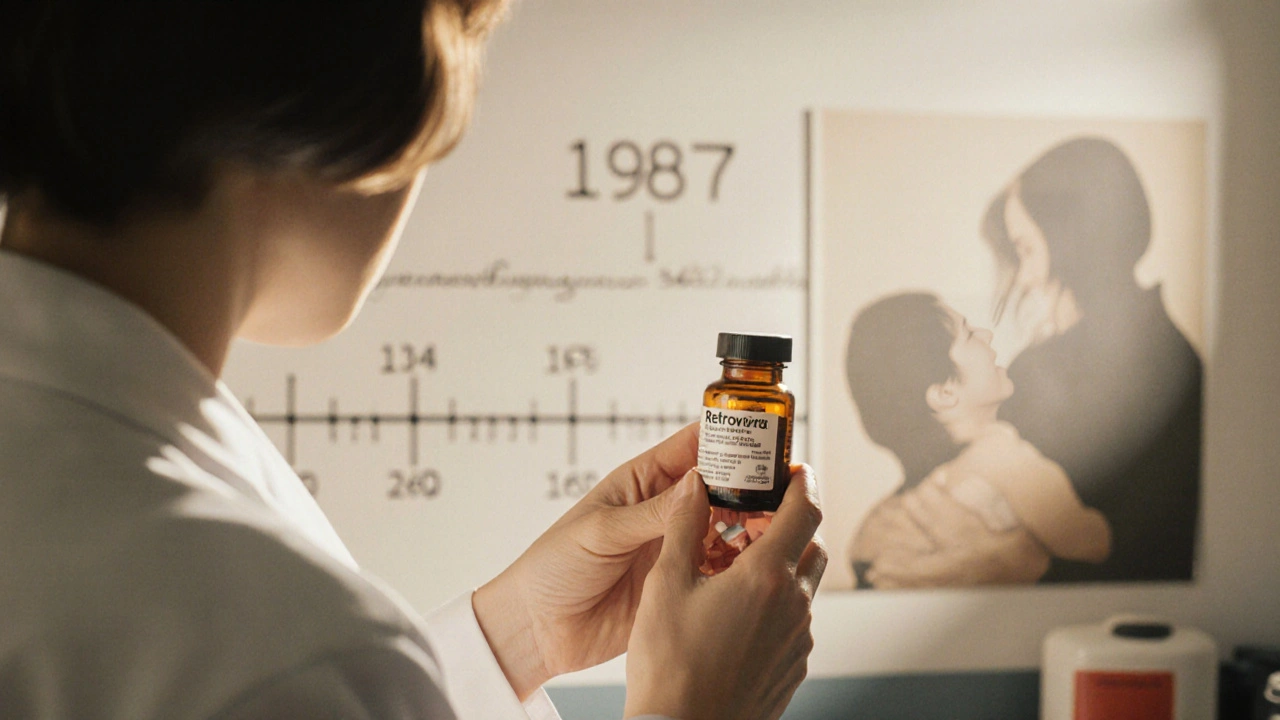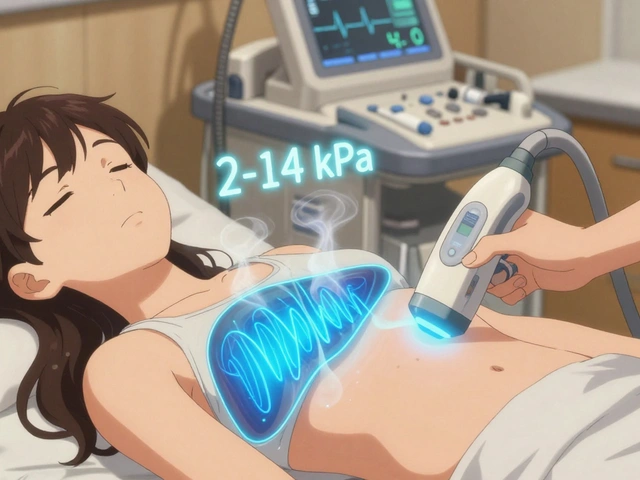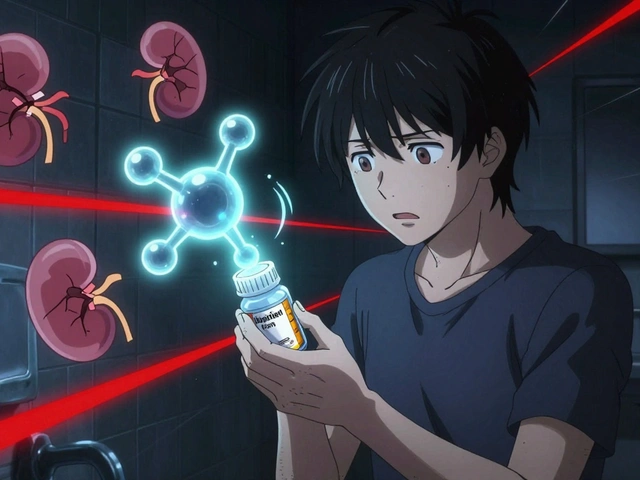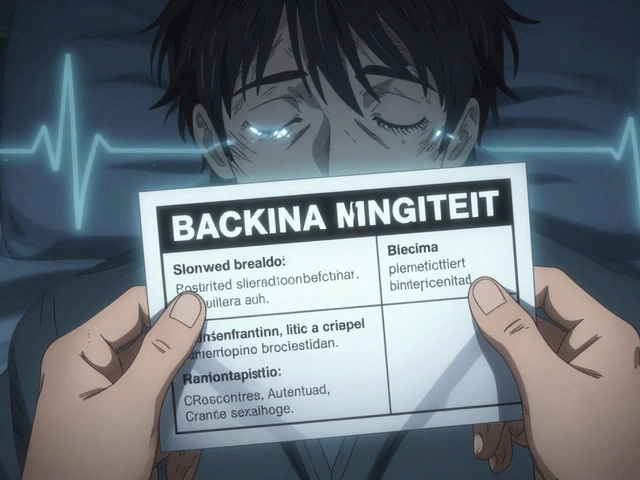NRTI Comparison Tool
Drug Comparison: vs
| Characteristic | ||
|---|---|---|
| Drug Class | ||
| Typical Dose | ||
| Common Side Effects | ||
| Pregnancy Category | ||
| Average Monthly Cost |
Important Notes
- Retrovir (Zidovudine) has a higher risk of hematologic side effects
- Newer NRTIs generally offer better tolerability and once-daily dosing
- Cost differences have narrowed with generics available for all drugs
- Pregnancy safety profiles vary - consult guidelines for current recommendations
Key Takeaways
- Retrovir (Zidovudine) is an older NRTI with strong evidence for preventing mother‑to‑child transmission but a higher side‑effect burden.
- Modern alternatives such as tenofovir, lamivudine, and emtricitabine offer better tolerability, lower anemia risk, and simpler once‑daily dosing.
- Cost differences have narrowed; generic Zidovudine remains cheap, yet newer drugs are often covered by insurance.
- Resistance patterns matter: Zidovudine‑resistant HIV may still respond to other NRTIs.
- Pregnancy safety varies - Zidovudine is category C, while tenofovir and lamivudine have more robust data for use in pregnant patients.
What is Retrovir (Zidovudine)?
Retrovir is a nucleoside reverse transcriptase inhibitor (NRTI) that blocks the HIV reverse‑transcriptase enzyme, halting viral replication. First approved by the FDA in 1987, it was the pioneer antiretroviral and remains on the WHO essential medicines list.
Typical adult dosing is 300 mg twice daily, taken with food to reduce gastrointestinal upset. Its main pharmacologic actions are incorporation into the viral DNA chain and termination of elongation.
How NRTIs Work in HIV Treatment
All NRTIs are structural analogues of natural nucleosides. After entering a CD4+ cell, they are phosphorylated to the active triphosphate form, which competes with the natural substrate during reverse transcription. When an NRTI is incorporated, it lacks a 3’‑OH group, preventing the next nucleotide from attaching and thus stopping the viral genome from extending.
This mechanism underlies both efficacy and toxicity: the same enzymes that process human DNA can mistakenly act on mitochondrial DNA, leading to side effects such as anemia or peripheral neuropathy.
Alternatives to Zidovudine
When clinicians look for Zidovudine alternatives, they usually consider other NRTIs that share the same target but differ in pharmacokinetics and safety profile. Below are the most widely used options.
Lamivudine is a cytidine analogue with a very low toxicity profile, approved in 1995.
Tenofovir disoproxil fumarate (TDF) is a nucleotide analogue first approved in 2001; it offers strong potency and once‑daily dosing.
Abacavir is a guanosine analogue introduced in 1998, notable for its rapid viral load reduction but requiring HLA‑B*57:01 screening.
Emtricitabine is a fluorinated cytidine analogue approved in 2003, often paired with tenofovir in a single‑tablet regimen.
Side‑by‑Side Comparison
| Drug | Class | FDA Approval | Typical Dose | Common Side Effects | Pregnancy Category | Average US Generic Cost (30‑day) |
|---|---|---|---|---|---|---|
| Retrovir (Zidovudine) | NRTI | 1987 | 300mg BID | Anemia, neutropenia, nausea | C | $20‑$30 |
| Lamivudine | NRTI | 1995 | 300mg QD | Headache, mild fatigue | B | $15‑$25 |
| Tenofovir DF | Nucleotide RTI | 2001 | 300mg QD | Renal dysfunction, bone loss | B | $25‑$35 |
| Abacavir | NRTI | 1998 | 600mg QD | Hypersensitivity (requires HLA‑B*57:01 test) | B | $30‑$40 |
| Emtricitabine | NRTI | 2003 | 200mg QD | Diarrhea, mild rash | B | $20‑$30 |
Deep Dive: Efficacy and Resistance
Zidovudine showed a 72% reduction in mother‑to‑child transmission when given in the third trimester. However, its potency against contemporary HIV‑1 subtypes is modest compared with tenofovir or emtricitabine, which achieve faster viral load suppression.
Resistance mutations differ. Zidovudine‑resistant virus often carries theM184VorK65Rmutations, which also reduce susceptibility to lamivudine and tenofovir. Conversely, tenofovir resistance (e.g.,K70E,K65R) does not markedly affect zidovudine activity, making it a useful backup when tenofovir failure is documented.
Safety Profile: What to Watch For
The biggest drawback of Retrovir is hematologic toxicity. Anemia occurs in up to15%of patients and may necessitate dose reduction or a switch to another NRTI. Neutropenia can increase infection risk, especially in patients with concurrent opportunistic infections.
Lamivudine and emtricitabine have the cleanest safety records-rarely cause blood abnormalities and are well tolerated in older adults.
Tenofovir’s safety concerns revolve around kidney function. Baseline creatinine clearance should be >60mL/min, and periodic monitoring is advised. Bone mineral density loss is also documented, especially in adolescents.
Abacavir’s hypersensitivity reaction can be life‑threatening (10% incidence in HLA‑B*57:01‑positive individuals). Genetic screening eliminates that risk, but the extra testing step adds cost and complexity.
Pregnancy Considerations
Zidovudine’s role in preventing vertical transmission remains endorsed by WHO, but newer guidelines favor a triple‑drug regimen that includes tenofovir and lamivudine or emtricitabine because they provide higher barrier to resistance and better maternal health outcomes.
Both lamivudine and emtricitabine are classified as categoryB, with extensive safety data from large pregnancy registries. Tenofovir is also categoryB, though recent data suggest a slightly increased risk of pre‑term birth-still considered acceptable when benefits outweigh risks.

Cost and Accessibility
Retrovir’s generic version is the cheapest NRTI on the market, often priced under$30per month in the United States. Tenofovir, lamivudine, and emtricitabine have become generic in recent years, narrowing the price gap; many insurance plans place them at comparable co‑pay levels.
In low‑resource settings, the World Health Organization’s 2023 treatment guidelines list tenofovir+lamivudine+dolutegravir as the preferred first‑line regimen, reserving zidovudine mainly for patients with contraindications to tenofovir.
When to Choose Retrovir
- Pregnant patients in settings where tenofovir is unavailable or contraindicated.
- Patients with documented tenofovir or lamivudine resistance but no zidovudine resistance.
- When cost constraints make the $20‑$30 generic price the deciding factor.
- In combination with other agents to create a high‑genetic‑barrier regimen for treatment‑experienced individuals.
If none of the above apply, most clinicians opt for tenofovir+lamivudine (or emtricitabine) because of superior tolerability and stronger viral suppression.
Practical Checklist for Switching or Starting Therapy
- Review baseline labs: hemoglobin, neutrophil count, serum creatinine, and bone density if tenofovir is considered.
- Screen for HLA‑B*57:01 before prescribing abacavir.
- Check for drug‑drug interactions: zidovudine can increase toxicity when combined with certain chemotherapeutics.
- Confirm pregnancy status and discuss risks/benefits of each NRTI.
- Assess insurance coverage and compare out‑of‑pocket costs for generic options.
- Plan follow‑up labs at 4weeks after initiation or any regimen change.
Frequently Asked Questions
Is Retrovir still used in first‑line HIV therapy?
In high‑income countries, zidovudine is rarely a first‑line choice because newer NRTIs offer better tolerability and once‑daily dosing. However, it remains part of recommended regimens for preventing mother‑to‑child transmission in resource‑limited settings.
Can I take Retrovir with tenofovir?
Yes, but this combination is not standard because both drugs target the same step in viral replication, offering limited added benefit and increasing the risk of hematologic toxicity. Clinicians typically pair zidovudine with a non‑NRTI such as a protease inhibitor.
What monitoring is required for zidovudine‑induced anemia?
Baseline hemoglobin should be ≥12g/dL. Repeat CBC every 4‑6weeks for the first three months, then quarterly. If hemoglobin drops below 9g/dL, consider dose reduction or switching to an alternative NRTI.
Are there generic versions of the newer NRTIs?
Yes. Since 2022, generic lamivudine, tenofovir disoproxil fumarate, and emtricitabine have been FDA‑approved, bringing their prices close to that of zidovudine.
How does resistance to zidovudine affect future treatment options?
Zidovudine resistance often involves theM184Vmutation, which also reduces susceptibility to lamivudine and emtricitabine but makes the virus more fit for tenofovir. Therefore, patients with zidovudine failure are frequently switched to tenofovir‑based regimens.






11 Comments
Ted G
October 7, 2025Ever notice how the big pharma giants love to push old drugs like Retrovir while they secretly funnel cash into shadow labs? They're counting on us to trust outdated data while they fine‑tune the next wave of surveillance meds. The fact that Zidovudine still haunts guidelines is a clue they don’t want us to see the newer, safer options. You think it’s about patient care, but it’s really about control and profit. Wake up before they rewrite the story again.
Miriam Bresticker
October 13, 2025🤔 consider the philosophical underpinnings of medicine; we are not just treating viruses but confronting the absurdity of existence. The trade‑off between cost and safety feels like a modern allegory, wen we really need to ask: are we serving the body or the market? 🌟
Claire Willett
October 19, 2025Consider pharmacokinetic profiles; Zidovudine has a higher hematologic toxicity index vs tenofovir. Switch regimens when M184V is present.
olivia guerrero
October 24, 2025Wow, what a comprehensive breakdown!! 🚀 The evolution from Retrovir to newer NRTIs is truly amazing!!! 🎉 It really shows how far we've come, and it's exciting to think about where we're headed next!!!
Dominique Jacobs
October 30, 2025Hey, great point on the toxicity index! If you're already tracking M184V, jumping to tenofovir or lamivudine can save you a lot of headaches-no joke. Plus, the once‑daily dosing keeps patients on track, which is a win‑win for adherence and outcomes.
Claire Kondash
November 5, 2025When we dive deep into the pharmacological tapestry that underlies antiretroviral therapy, we uncover layers of history, biology, and even sociopolitical nuance that shape every prescription decision. 🌐 The story of Retrovir (Zidovudine) begins in the late 1980s, a time when the AIDS crisis forced the medical community to innovate at breakneck speed, producing a drug that, while pioneering, carried an inherent risk of bone‑marrow suppression. 🩸 Those early trials were conducted under immense pressure, and the data, though groundbreaking, reflected a compromise between efficacy and tolerability that modern clinicians still grapple with. ✨ Fast forward to the present, and we have a robust armamentarium of NRTIs-lamivudine, tenofovir, emtricitabine, abacavir-each offering a distinct pharmacokinetic profile, resistance barrier, and side‑effect footprint. 🧬 The shift from a twice‑daily 300 mg dose of Zidovudine to a once‑daily 300 mg dose of tenofovir represents not just a convenience upgrade but a paradigm shift in patient adherence strategies. 📈 In low‑resource settings, the WHO's endorsement of tenofovir + lamivudine + dolutegravir as first‑line therapy underscores the global consensus that newer agents provide superior virologic suppression while minimizing toxicities. 🌍 Yet the cost narrative cannot be ignored: generic Zidovudine remains tantalizingly cheap at $20‑$30 per month, a factor that's still decisive for many uninsured patients. 💰
From a resistance standpoint, the mutational pathways differ sharply. Zidovudine resistance often involves the M184V mutation, which paradoxically sensitizes the virus to tenofovir, creating a strategic advantage when designing salvage regimens. Conversely, tenofovir resistance (e.g., K65R) does not impact Zidovudine efficacy, giving clinicians a flexible toolbox. 🛠️ The pregnancy safety profile adds another layer: Zidovudine's category C status historically made it the go‑to for preventing mother‑to‑child transmission, but contemporary guidelines now favor tenofovir and lamivudine (both category B) due to their extensive safety data. 🤱
Ultimately, the decision matrix for selecting an NRTI hinges on individualized patient factors-baseline hemoglobin, renal function, bone density, HLA‑B*57:01 status, and even geographic drug availability. 🩺 As we continue to refine treatment algorithms, the overarching goal remains clear: maximize viral suppression while preserving quality of life, a balance that newer NRTIs achieve more gracefully than Retrovir ever could. 🚀
Matt Tait
November 11, 2025Honestly, that essay is a bit overblown. Zidovudine’s problems are well‑known, and the newer drugs aren’t magic bullets. The cost differences are practically negligible now, so the hype feels unnecessary.
Benton Myers
November 17, 2025Interesting comparison.
Pat Mills
November 22, 2025Let me be crystal clear: the American spirit thrives on innovation, and dismissing Zidovudine as merely a relic does a disservice to the pioneers who battled an unseen enemy with limited tools. Our nation’s resolve to fund cutting‑edge research led to the development of tenofovir and emtricitabine-drugs that not only outperform older regimens but also embody the very ethos of progress that defines the United States. When we lower the bar by insisting that every new therapy must be cheaper than a generic from the 1980s, we betray the legacy of those who risked everything to bring life‑saving treatments to the forefront. Moreover, the narrative that cost alone dictates therapeutic choice undermines the principle of equitable healthcare, a cornerstone of our democratic ideals. Yes, Zidovudine remains inexpensive, but its hematologic toxicity can burden patients with additional medical expenses and compromised productivity-costs that our robust healthcare system aims to minimize. By championing newer NRTIs, we reinforce a future where American patients receive the safest, most effective care without compromising fiscal responsibility. In the grand tapestry of medical history, the United States stands at the vanguard, daring to replace the old with the superior, for the betterment of all.
neethu Sreenivas
November 28, 2025💚 You articulated the importance of progress beautifully, and I completely agree that patient safety should never be compromised for the sake of cost alone. 🙏 It’s encouraging to see a perspective that values both innovation and equitable access-thank you for sharing such a thoughtful analysis! 🌟
Keli Richards
December 4, 2025While the comparison outlines the basic pharmacologic facts, it would benefit from a more structured presentation. Including a clear summary of key differences and patient selection criteria would aid clinicians in decision‑making.